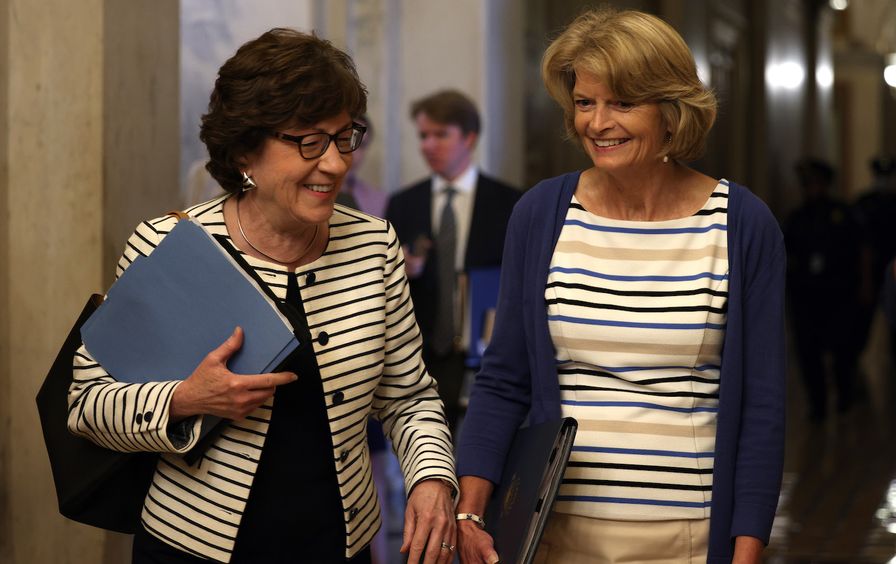| John Nichols | The Nation |
The days of broad bipartisan support for the confirmation of US Supreme Court nominees are, by every indication, behind us. But it still matters that Judge Ketanji Brown Jackson was confirmed to serve on the court Thursday with a 53-47 Senate majority that included both Democrats and Republicans. And it is worth noting that two of the three Republican votes came from senators who represent states where election systems have been reformed to allow for ranked-choice voting.
Under ranked-choice voting , or RCV, voters do not merely pick between a Democratic and Republican nominee. They rank candidates on a list, and if their first-choice candidates lose, their votes are redistributed to their next choices until a candidate emerges with a clear majority. One strength of the RCV system is that it encourages candidates to appeal to voters from across the political spectrum. Instead of worrying only about exciting a base of hyper-partisan supporters, candidates have an incentive to take stands that might attract votes from members of other parties.
”Reforms like this help us get beyond knee-jerk, zero-sum calculations.
That’s what Alaska Senator Lisa Murkowski and Maine Senator Susan Collins did when they joined the most boldly independent member of the Senate Republican Caucus, Utah’s Mitt Romney, and all 50 Senate Democrats in voting to confirm the nomination of the first Black woman who will serve on the high court. Jackson’s qualifications, along with her stellar presentation before the Senate Judiciary Committee and the embarrassing misfires by Republicans on the committee who attempted to discredit her , undoubtedly made it easier for Murkowski, Collins, and Romney to vote for her confirmation. And all three of these senators have shown at least some willingness to break with their party’s leadership. But there is a good case to be made that the RCV systems in Alaska and Maine made it easier for Murkowski and Collins to follow their consciences and support an exemplary nominee.
Murkowski’s vote was the most notable, as she is up for reelection this year, and faces a Republican rival, Kelly Tshibaka, a former commissioner of the Alaska Department of Administration who is backed by Donald Trump and his allies . Under the standard election system that is used in the vast majority of American states, Murkowski would be fighting for her political life in an August 16 Republican primary dominated by the party’s right wing. The prospect of Murkowski casting her vote for a Democratic president’s nominee for the Supreme Court who was opposed by the vast majority of Senate Republicans and by interest groups and donors associated with the Trump-dominated GOP would have been nil.
But Alaska ditched the traditional system in 2020 and approved sweeping reforms to develop a new approach to primaries and general elections. Partisan primaries were replaced with a single nonpartisan “blanket primary” including candidates from all parties. The top four primary finishers then advance to a general election to be decided by ranked-choice voting, which is also referred to as instant-runoff voting.
What this means, practically, is that Murkowski and Tshibaka are both likely to come through the primary and end up on the November ballot, probably with a lesser-known Democrat and perhaps with a Libertarian or an independent. It’s not unreasonable to suggest that this prospect gave Murkowski an added incentive to vote for Jackson.
“[Murkowski’s] going to need moderate Republican, independent and Democratic votes in November. She knows she’ll need those second- and third-choice votes,” explained Rob Richie, the president of FairVote, the election reform group that has long advocated for ranked-choice voting and other initiatives to expand and improve democracy. “In this circumstance, she couldn’t alienate Democrats. I think it really did push her toward [supporting Jackson]. She couldn’t have Democrats saying, ‘She wouldn’t even vote for our very sensible, highly qualified Supreme Court nominee.’”
Maine has a somewhat different RCV system. Under the Maine system, which was implemented in 2018 , there is no nonpartisan blanket primary. Instead, the nominees of the major parties and independent and third-party candidates appear on the November ballot, and voters can then rank them. But the Maine system still establishes incentives for officials to take stands that attract voters from other parties.
“It gives [Collins] options that she might not otherwise have,” explained Richie.
Both Collins and Murkowski announced their decisions to back Jackson with understandable references to the nominee’s qualifications to serve on the high court. They didn’t mention voting systems. But Murkowski did reflect on the fact that she is seeking reelection this year, telling reporters that she has “assumed a level of risk” in deciding to break with most Senate Republicans to back a Democratic president’s nominee for the court.
There has been widespread speculation that Alaska’s new system has significantly reduced the risk for Murkowski. Indeed, in a 2021 analysis of the RCV reform in Alaska, Jeannette Lee , a senior researcher with the Sightline Institute’s office in Anchorage, noted, “Alaska’s election reforms grant Murkowski even more freedom to follow her conscience and be pragmatic….. The new system has essentially liberated Murkowski from the risk of being outflanked by extreme partisans in a closed party primary.”
That is the genius of ranked-choice voting, explained Richie, as he reflected on the Republicans who voted to confirm Judge Jackson. “This shows how voting systems really can create incentives for elected officials to break out of the partisan mold. Reforms like this help us get beyond knee-jerk, zero-sum calculations. They create incentives for senators to get outside of narrowly defined ideological and political boxes.”






